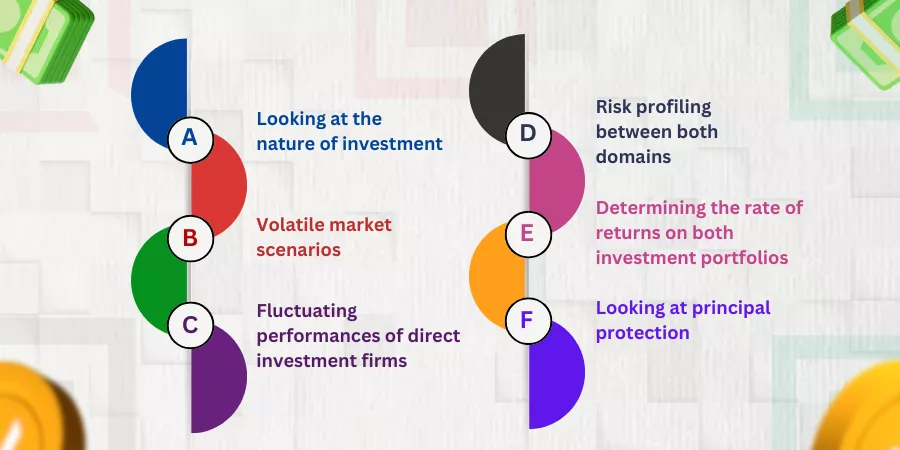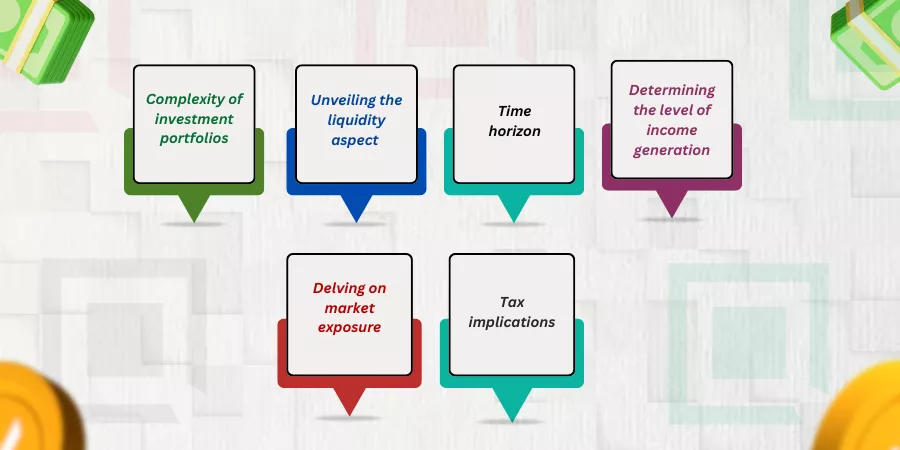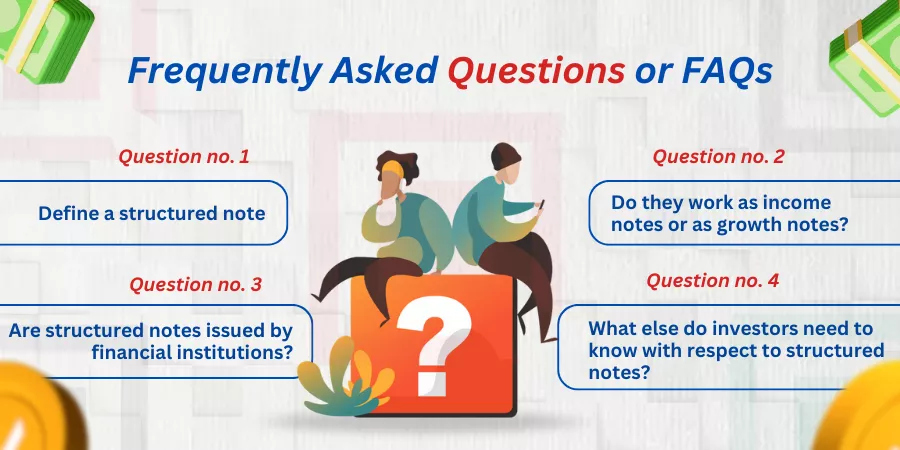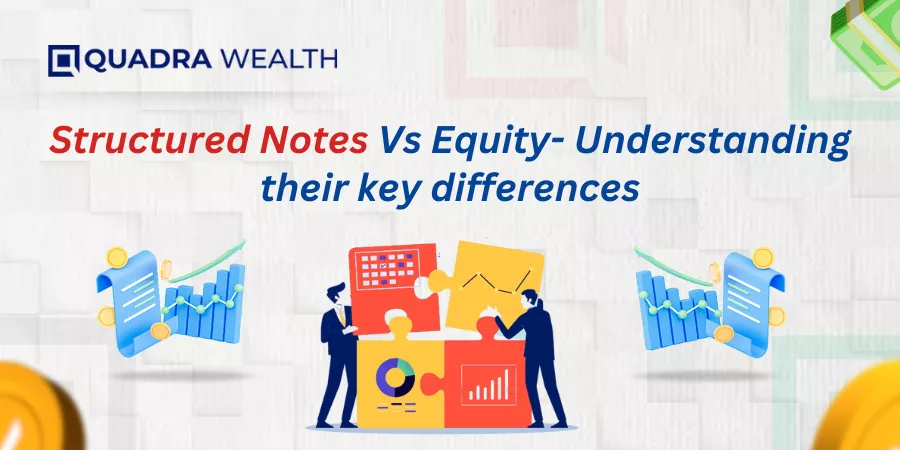Introduction
As a newbie investor, you can have two strategic options when it comes to investing. You can stick to the traditional methods of investing as follows
- Investing your money via govt-aided bonds or CDs
- Working with a stock exchange broker and dealing with different types of equities
But today’s Gen Zs and Alpha Gens do not have the traditional mindset of yesteryear investors. Today’s young generation of men and women do not mind taking those extra risks and are more tech-savvy after all.
Therefore, with the advent of the internet, the investment and financing world is undergoing a paradigm shift in terms of introducing more customized and tailormade options for investing. That is primarily how structured notes started gaining popularity.
What are structured notes? Well, these are hybrid securities that comprise an optimal mix of debt as well as equity. The bond component provides upside or downside protection against capital loss while the returns on investment are more likely to be linked with the performance of assets that underlie the notes.
The assets can comprise equities, high-paying shares or securities, currencies, credit notes, a basket of Fortune 500 stocks, and commodity futures and the options can be a wide range of financial derivatives that you get to choose from.
Which option do you think is better? Well, that is exactly why you should read this particular blog titled ‘Structured Notes Vs Equity’. Helping you get started further:

Looking at the nature of investment
Structured notes are hybrid securities that combine debt as well as equity. Here, the promissory bond is curated in the name of the investor. The bond component protects the capital investment or the principal amount of the investor to a greater extent. However, as the notes also comprise variable derivatives as a part of their asset component, the returns of investment on the notes can also be variable in nature. Therefore, the potential returns of the notes are also linked to the performance of underlying assets the notes are linked with.
Whereas, with respect to equities, these are shares, securities, or stocks of direct investment companies. Here, the investor gets ownership of the stakes of the companies’ assets, per se. The stocks and shares however keep fluctuating. This is in terms of their prices. The shares or stocks keep fluctuating on account of:
- Volatile market conditions- Bearish and bullish trends
- Fluctuating performance levels of company’s performance
Let us have a brief explanatory outlook on each of the above:
Volatile market scenarios
In an equity market or stock exchange office, there are two kinds of scenarios that investors primarily contemplate. These are:
- Bearish trends and
- Bullish trends
A Bullish market is a more optimistic market wherein the prices of shares, stocks, or commodities indicate an increasing or a rising spree while a bearish market is a more pessimistic outlook of the market that indicates a fall in prices of shares, stocks, and commodities.
As an investor, you must buy your shares while it is bearish and sell your shares while the market indicates bullish trends. The investment portfolio comprising of equity alone is therefore constantly subject to the rise or fall in prices in the equity market.
Fluctuating performances of direct investment firms
When you invest in shares or stocks of direct investment firms, you get dividends or profit-sharing ratios on the stake of the company. The company can offer direct investment shares to employees, the general public, and the directors of the firm.
When the company faces losses or depicts fluctuating performances in the market, the shares or stocks of direct investments can also differ or fluctuate accordingly.
Risk profiling between both domains
As you all are quite aware, structured notes are predefined notes that get curated at their initial stages of inception. Therefore, the terms of the note with respect to the tenor period, interest or capital earnings, and repayment of investment post-maturity are predefined during the time of their inception itself.
Therefore, the risk profiling of this investment is predefined between the investor and the product issuing firm. Some notes may provide you with a complete degree of capital protection while with few others, you might face that there are risks involved as investors receive only a portion of their capital or principal investment. This is because the notes are tied to underlying derivatives whose prices keep fluctuating.
In a nutshell, the risk lies in the underlying performance vis-a-vis the terms of the notes.
Whereas, with respect to equities, the performance of shares, stocks, or commodities fluctuates very vividly. Therefore, investors face higher market volatility on account of the company’s performance indexes or through broader market scenarios. Equity holders therefore can experience significant gains or losses.
Determining the rate of returns on both investment portfolios
The rates of return for a structured note may depend on the performance of the underlying assets the note is linked with. Therefore, the returns of the note can either be fixed or floating depending on the terms of the note. Sometimes, product issuing firms apply capped limits or ceiling limits based on which the returns of the note are capped or limited.
Whereas, with respect to equity, the investors have unlimited potential to get earnings via the company’s hiked-up shares, stocks, or company-earned profits. Investors can therefore capitalize on increased earnings via the company’s growth or stock appreciation. However, the prices of shares or company equity can also plummet when the company’s performance in the market is not all that great. Therefore, returns on investment for equity-related shares or derivatives highly fluctuate for the investors.
Looking at principal protection
For those of you who aim for complete principal protection from notes, you can aim for principal-protected notes or PPNs. You can aim for principal-protected ELNs (Equity-Linked-Notes). Here, you get your complete cap investment back even if markets perform poorly. Investors get their capital returns with a broader outlook on stock markets too.
Whereas, with respect to equities, a loss in the value of shares or stocks that you have purchased or procured from FMCG firms can erode the complete value of your capital investment. Therefore, principal protection is certainly not guaranteed for those of you who plan to invest with equity.

Complexity of investment portfolios
Structured notes have more complex terms and conditions as these are hybrid products that comprise a mix of debt and equity. The notes comprise derivatives, options, or other forms of dynamic financial instruments. Therefore, a newbie might find notes a tad harder to learn or understand.
Whereas, with respect to equity, the structure is relatively easier to learn or understand. As an investor, you purchase equities like stocks, shares, commodities, or futures with options. Therefore, you make direct investments with Fortune 500 companies that deal with different types of manufacturing and service-oriented products. The prices of these shares or stocks may fluctuate depending on the volatility of market conditions.
Unveiling the liquidity aspect
Structured notes are not so highly liquid owing to complex and customized terms and conditions the note is tied with. You may be able to sell smaller fragments of the notes via secondary market owners or give them away to product issuing firms. But, you cannot be very sure that you might fetch yourself a complete value for your capital investment.
Whereas, with equity, the shares and securities are highly liquid. Meaning, that you can sell equity products at any time at prevailing market rates. Therefore, you need not hold stocks or shares over a longer tenor period, unlike other investment portfolios.
Time horizon
Structured notes come to you with fixed-tenor periods. The maturity dates can last a few months from the dates the notes were issued until a few years for some of the notes. Investors cannot access their investment amount and may have to wait until the period of maturity. However, in case of a distress scenario, they can partially withdraw their investment funds and pay penalties or early redemption fees in lieu of the same.
Whereas, equity investors do not have any kind of hold-up period for the shares or stocks that they have purchased from direct investment firms. They can hold their equity indefinitely allowing them to buy or sell derivatives at any time of time. This way, they can buy or sell shares depending on their financial goals vis-a-vis market conditions.
Determining the level of income generation
Structured notes offer dividends, interest earnings, or coupons. However, all of this gets predefined on the notes that are curated and finalized during the stage of their inception itself.
Whereas, in the case of equities the earnings or profit margins you might receive through stocks or shares might fluctuate owing to volatile market conditions.
Delving on market exposure
Structured notes have a wider market exposure as they deal with bond components, equities, currencies, credit-linked notes, and a whole lot of financial derivatives. The investors can therefore seek customized solutions by picking those financial instruments they are confident that they can deal with.
Whereas, in the case of equity, the investors directly deal with investments in the company’s shares or stocks. As the investor deals with a company’s share or derivative, the value of the asset depends on the overall performance of the firm. Here, the exposure is restricted to that of the company’s shares that you hold and therefore the exposure is more concentrated.
Tax implications
With structured notes, the interest earnings, coupons, or dividend reimbursements may be treated as regular income or as capital gains. You must consult a tax adviser to get valuable cue cards with respect to the same.
Whereas, with equity, the taxes on dividends or capital earnings are treated as capital gains. The tax slabs are worked out accordingly.
The Bottom Line
While structured notes can more a more tailored approach with respect to investing, the downside here is the complexity that is involved in this form of investing for a newbie to learn or understand. The notes are also less liquid in nature.
While, with equities, they are more straightforward investment options that offer investors better liquidity to buy or sell equity products anytime they want to.
You may have to understand the pros and cons of each investment option before you zero in on one.
What are your thoughts on this? Do let us know in the comments below!
Frequently Asked Questions or FAQs

Define a structured note
Answer: A structured note is a type of derivative component that hybrids with that of a bond. Therefore, you can find different types of structured notes you can customize based on investment preferences.
Do they work as income notes or as growth notes?
Yes, a structured note can act both as an income note as well as a growth note. These notes can offer investor interest earnings based on the interest rates that were incubated while the notes were being designed. On the contrary, when you have etfs, equity, or derivatives as underliers for your note, they can appreciate in the longer run helping you grow your investment portfolio. Hence, the notes can be deemed as growth notes too.
Are structured notes issued by financial institutions?
Answer: Yes, structured products can be issued by financial institutions like wealth management firms, investment-grade banks and also by independent financial practitioners to investors across the globe.
The advisor helps you choose assets like equities, derivatives, or foreign currencies whose values are subject to change due to the fleet of market risks the underliers are exposed to. The issuer or treasury firm therefore tells investors that is the return is based on a performance-based initiative of underliers that lie herein.
What else do investors need to know with respect to structured notes?
Understanding structured notes is essential to know what their risks vs downsides are. You must understand the common types of notes before you start investing in structured notes.






